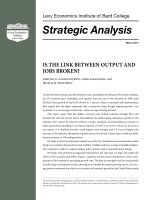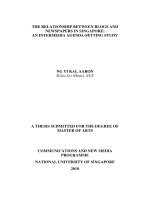ENDING THE WAR BETWEEN WORK AND FAMILY
Bạn đang xem bản rút gọn của tài liệu. Xem và tải ngay bản đầy đủ của tài liệu tại đây (189.93 KB, 7 trang )
17. září 2004
281 ze 412
16
ENDING THE WAR
BETWEEN WORK AND
FAMILY
HOW CAN PERSONAL MASTERY
AND LEARNING FLOURISH AT
WORK AND AT HOME?
In 1990 a
Fortune
magazine cover story, titled "Why Grade A Ex-
ecutives Get an F as Parents," observed that children of successful
executives are more likely to suffer a range of emotional and health
problems than children of "less successful" parents.
1
For example, one
Ann Arbor Michigan study found that 36 percent of the children of
executives undergo treatment for psychiatric or drug abuse each year,
vs. 15 percent of children of non-executives in the same companies.
The author went on to cite the executives' long hours and personal
characteristics (perfectionism, impatience, and efficiency) as the chief
culprits and counseled that high-powered managers need to learn how
to boost their children's "self esteem." What was most interesting
about the article, however, was what it didn't say. Nothing was
mentioned about how the executives' organizations contributed to
their problems as parents or what they might do to improve
17. září 2004
282 ze 412
between Work ana Famn
matters. It seems that the author, like most of the rest of us, simply
accepts the fact that work inevitably conflicts with family life, and that
the organization has no part to play in improving imbalances between
work and family.
In recent years, I have noticed a considerable increase in concern
over the work-family issue among participants in our Leadership and
Mastery programs. Today, "finding balance between my work and my
family" is cited as a number-one priority by more attendees than any
other single issue.
Traditional organizations undeniably foster conflict between work
and family. Sometimes, this is done consciously—through the simple
threat that, "If you want to get ahead here, you must be willing to
make sacrifices." More often, it is done inadvertently, by simply
creating a set of demands and pressures on the individual that inevi-
tably conflict with family and personal time. These demands include
travel, dinner meetings, the increasingly common breakfast meetings,
weekend retreats, and just plain old long hours at the shop. The
pressures arise primarily from the narrow focus on organizational
goals and objectives to the exclusion of personal goals and objectives.
In other words, if all that matters is the organization's goals, there is
simply "no space" for weighing the cost of those goals for an
individual or the individual's family.
The disciplines of the learning organization will, I believe, end the
taboo that has surrounded the topic of balancing work and family,
and has kept it off the corporate agenda. The learning organization
cannot support personal mastery without supporting personal mas-
tery in all aspects of life. It cannot foster shared vision without
calling forth personal visions, and personal visions are always mul-
tifaceted—they always include deeply felt desires for our personal,
professional, organizational, and family lives. Lastly, the artificial
boundary between work and family is anathema to systems thinking.
There is a natural connection between a person's work life and all
other aspects of life. We live only one life, but for a long time our
organizations have operated as if this simple fact could be ignored, as
if we had two separate lives.
THE STRUCTURE OF WORK/FAMILY IMBALANCE
There is a systems archetype underlying the work-family imbalance.
This archetype is called "Success to the Successful" because it consists
of two reinforcing growth processes, each of which tend to fuel
17. září 2004
283 ze 412
increasing levels of success—albeit to competing activities. This ar-
chetype underlies a wide variety of situations where individuals,
groups, or organizations compete for a limited resource. The success
of one means that it tends to get more of the resource, which then
reduces the success of the others. The resource could be limited
dollars to invest in competing divisions of a business. It could be
limited praise of a teacher in a crowded classroom. Or it could be
the limited time of a busy manager:
At the top of the diagram, there is the reinforcing (amplifying)
growth of time and commitment in one's work: more time leads to
greater success, which leads to more and more interesting opportu-
nities and more desire for time at work, which leads to still more
time at work. At the bottom of the diagram is a similar reinforcing
growth of time and commitment at home: more time at home leads
to more "success" (satisfying family relationships, healthy kids,
family fun) at home, which leads to the desire for still more time at
home. The two reinforcing processes are connected because if time at
work goes up there is less time available for home, and vice versa.
2
Like other structures dominated by reinforcing feedback (recall
the "escalation structure" underlying the arms race), the "Success to
the Successful" archetype is intrinsically unstable. Once it starts to
drift one way or another, it will tend to continue to drift. And there
are several reasons why it tends to drift toward more and more time at
work. First, there is the matter of income. If time at work falls too
far, income falls and creates pressure for more time at work.
17. září 2004
284 ze 412
(This could be drawn as a balancing process controlling time at work
but
is omitted from the diagram for simplicity.) Secondly,
the
rein-
forcing "time at home" process tends to be especially strong in
the
negative, "vicious spiral" direction. If you find yourself in a situation
where less time at home is leading to poorer family relationships,
there can be strong psychological pressures to avoid family problems
still further. "Pushing ahead" with one's work becomes a convenient
excuse for avoiding the anguish of going home to an unhappy spouse
and troubled children. As you spend less time at home, "success in
family" diminishes further, leading to still less desire for family time.
Thirdly, for most highly successful professionals, there are more
"external" pressures for time at work than for time at home: norms
of twelve- to fifteen-hour days for high performers, new opportunities
that require more travel, subtle peer pressure from colleagues with
their own family problems.
Because of the dominant reinforcing feedback in "Success to the
Successful," the imbalances are not self-correcting. Indeed, they
grow worse and worse over time. This is why work-family issues are so
vexing.
For several years, we have worked with this archetype in training
programs. It has been fascinating to see how frequently people realize
the futility of trying to manage their lives from within this structure.
Any one-time improvement in, say, success in family tends to get
overwhelmed by the continually escalating pressures for more and
more time in work. Eventually, people realize that the structure itself
must be changed—you cannot cope successfully within it if you want
to achieve a balance between work and family because it will always be
driving you toward imbalance.
THE INDIVIDUAL'S ROLE
The first task is stepping outside the structure—asking yourself if,
given your ambitions, it is really your
vision
to have a balance between
work and family. How serious are you? This is not a trivial question.
If it were simple to achieve this balance, more people would do it.
Many people lament the problem, but few have made a conscious
choice to achieve the balance they espouse.
Making a conscious choice will entail setting clear personal goals for
time at home. For example, when will you be home at night? What
about dinner meetings? What about weekends? The
Fortune
17. září 2004
285 ze 412
article described several executives who committed themselves to
being home for dinner so many nights a week, gave up weekend golf,
and reduced evening business meetings. These may seem like modest
steps but they are exactly the types of steps required to translate a
vision of balance into tangible goals. Just setting goals without a
genuine vision will likely lead to backsliding when the goals prove
difficult to realize.
In some organizations, managers may pay a price in their career
opportunities if they take a stand for a vision of balance between
work and family. Very often, the person who takes such a stand will
command the respect of their peers—many of whom may wish that
they too could make a similar commitment. Nonetheless, such a
stand can also generate conflicts, especially between managers who are
committed to_Jbalance between work and family and those who are
not. I know of no simple advice to offer in such circumstances except
for these principles of personal mastery and enrollment:
• Identify what is truly important to you
• Make a choice (commitment)
• Be truthful with those around you regarding your choice
• Do not try to manipulate them into agreement or superficial sup
port
Ultimately, the consequences of individuals' choices regarding work
and family will depend, to a degree, on the overall organizational
climate.
THE ORGANIZATION'S ROLE
Ironically, conflicts between work and family may be one of the
primary ways through which traditional organizations limit their ef-
fectiveness and ability to learn. By fostering such conflict, they distract
and unempower their members—often to a far greater degree than
they realize. Moreover, they fail to exploit a potential synergy that can
exist between learning organizations, learning individuals, and learning
families.
"It's ironic," says Hanover's Bill O'Brien, "that we spend so
much time and money trying to devise clever programs for developing
leadership in our organizations and ignore a structure that already
exists, and which is ideal for the job. The more I understand the real
skills of leadership in a learning organization, the more I become
convinced that these are the skills of effective parenting.









